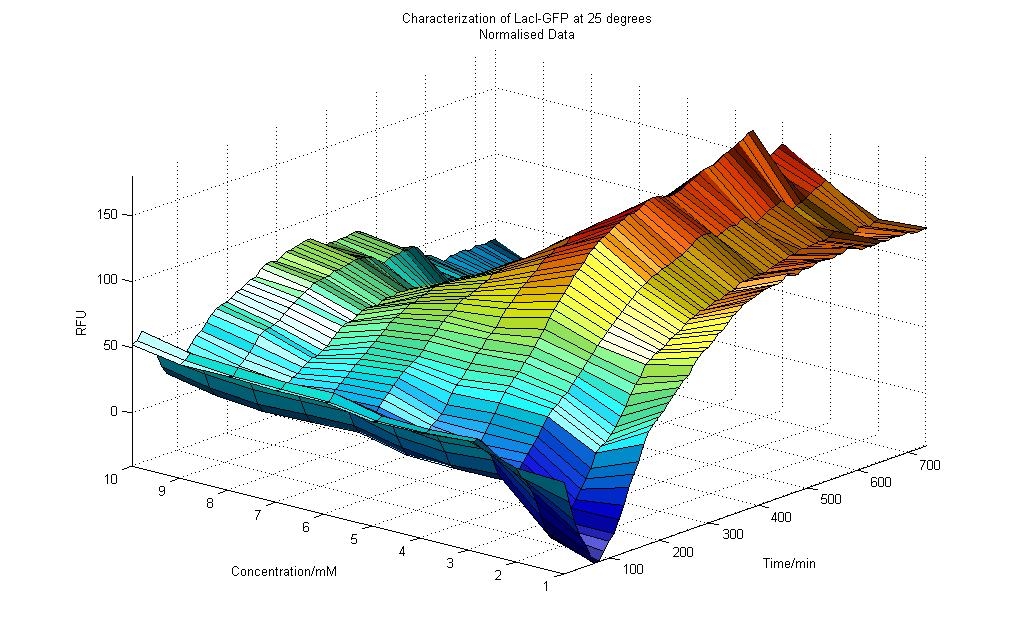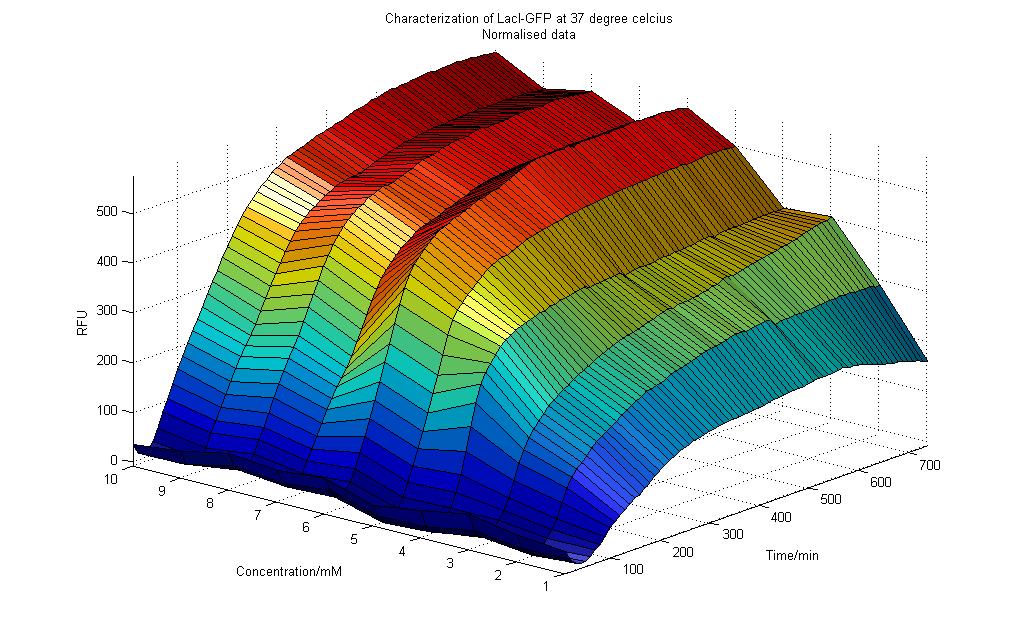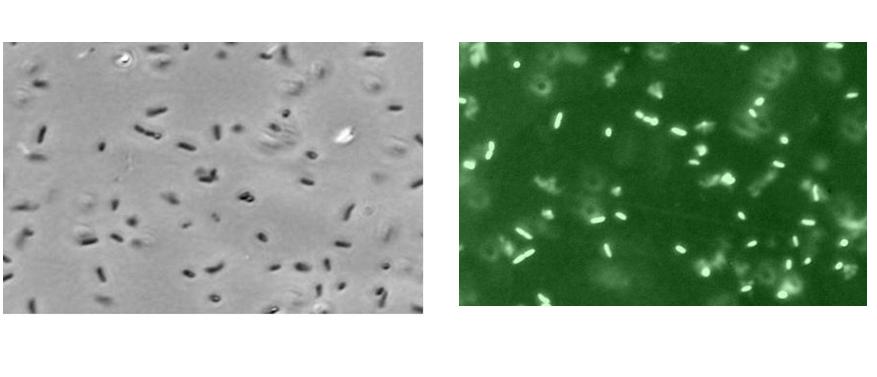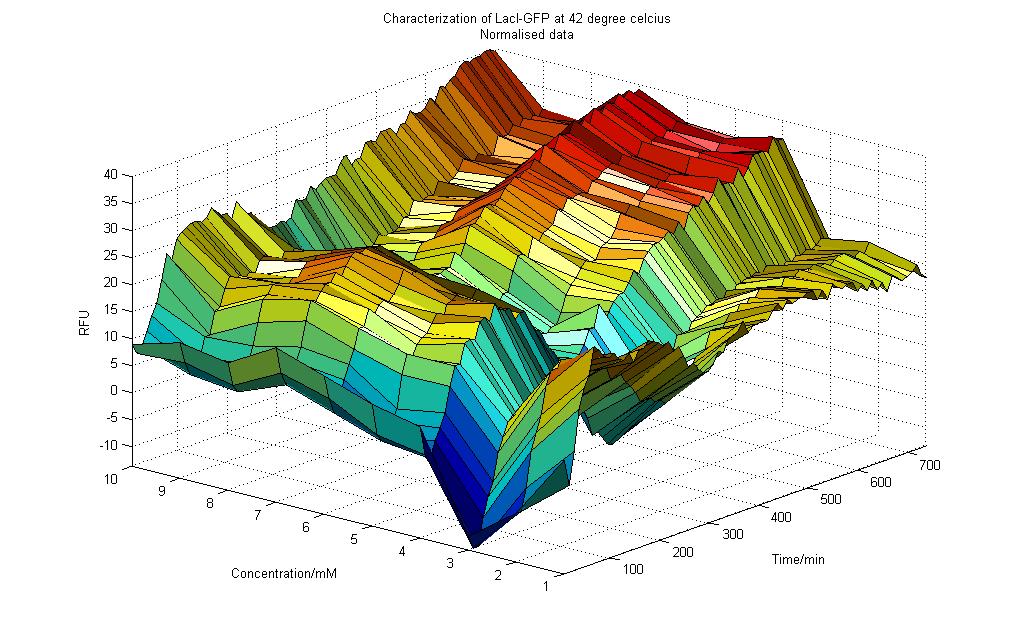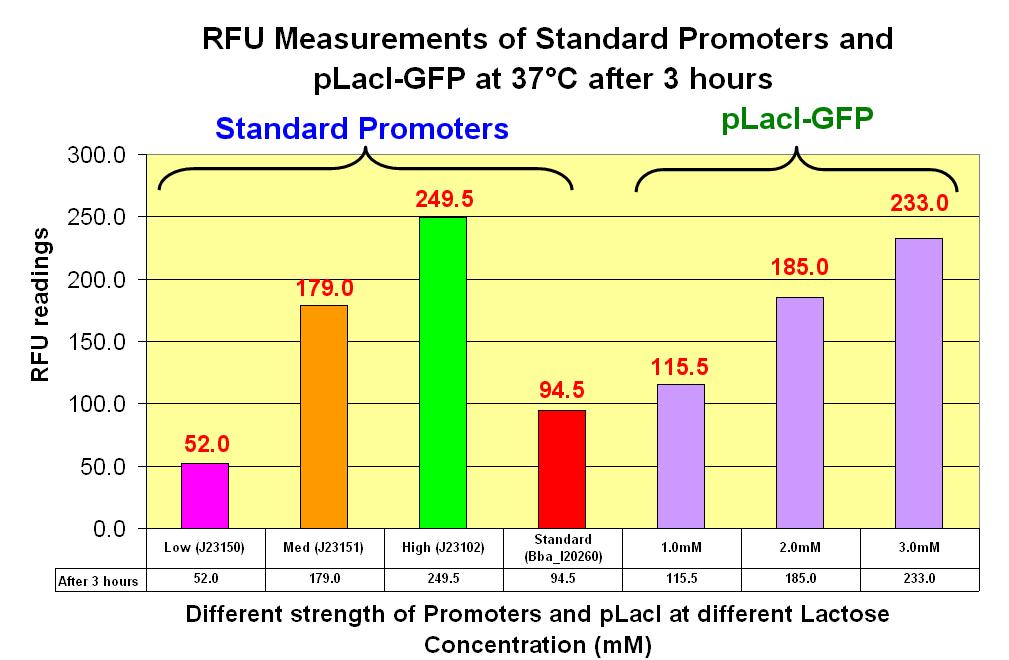Team:NTU-Singapore/Parts/Characterization of LacI-GFP
From 2008.igem.org
(→Verification) |
Lalala8585 (Talk | contribs) (→Results obtained at 25°C (Graph 4-1)) |
||
| Line 13: | Line 13: | ||
From the graph 4-1 of RFU vs. Lactose Concentration for the experiment conducted at 25°C, we could deduce the following: | From the graph 4-1 of RFU vs. Lactose Concentration for the experiment conducted at 25°C, we could deduce the following: | ||
| - | 1) For all concentration of Lactose (0 to 10mM), there were initial dips in RFU readings. This could be due the cells accommodating to a environment that was of a different medium and temperature. As previously, the cells were incubated at 37°C and in LB medium, but during the RFU measurement, the temperature was | + | 1) For all concentration of Lactose (0 to 10mM), there were initial dips in RFU readings. This could be due the cells accommodating to a environment that was of a different medium and temperature. As previously, the cells were incubated at 37°C and in LB medium, but during the RFU measurement, the temperature was 25° and M9 medium was used instead. |
| - | 2) After about 90 minutes, the RFU readings start to increase | + | 2) After about 90 minutes, the RFU readings start to increase. The cells most likely have become accustomed to the new environment. The effects of the Lactose inoculation took place, activating the LacI-GFP promoter and thus producing GFP proteins which led to a higher RFU measurement. |
| - | 3) | + | 3) An interesting observation was made. As more readings were taken over time, the effect of Lactose concentration was more significant for cells that were subjected to lower Lactose concentration. As shown in Graph 4-1, we could see that the RFU readings for lower concentration of Lactose were higher than that for the cells inoculated with a higher concentration of Lactose. |
| - | 4) After approximately 400 minutes, the RFU readings generally become constant with slight fluctuations observed. This could be due the cells reaching saturation where the lactose in the environment would not further increase the amount of GFP protein formed. This could also be due the cell reaching stationary phrase, where the cells would not be | + | 4) After approximately 400 minutes, the RFU readings generally become constant with slight fluctuations observed. This could be due to the cells reaching saturation where the lactose in the environment would not further increase the amount of GFP protein formed. This could also be due the cell reaching stationary phrase, where the cells would not be affected by the lactose in their environment. |
==Results obtained at 37°C (Graph 4-2)== | ==Results obtained at 37°C (Graph 4-2)== | ||
Revision as of 01:56, 13 October 2008
|
Contents |
Characterization of the existing LacI-GFP part (BBa_R0010)
Results obtained at 25°C (Graph 4-1)
From the graph 4-1 of RFU vs. Lactose Concentration for the experiment conducted at 25°C, we could deduce the following:
1) For all concentration of Lactose (0 to 10mM), there were initial dips in RFU readings. This could be due the cells accommodating to a environment that was of a different medium and temperature. As previously, the cells were incubated at 37°C and in LB medium, but during the RFU measurement, the temperature was 25° and M9 medium was used instead.
2) After about 90 minutes, the RFU readings start to increase. The cells most likely have become accustomed to the new environment. The effects of the Lactose inoculation took place, activating the LacI-GFP promoter and thus producing GFP proteins which led to a higher RFU measurement.
3) An interesting observation was made. As more readings were taken over time, the effect of Lactose concentration was more significant for cells that were subjected to lower Lactose concentration. As shown in Graph 4-1, we could see that the RFU readings for lower concentration of Lactose were higher than that for the cells inoculated with a higher concentration of Lactose.
4) After approximately 400 minutes, the RFU readings generally become constant with slight fluctuations observed. This could be due to the cells reaching saturation where the lactose in the environment would not further increase the amount of GFP protein formed. This could also be due the cell reaching stationary phrase, where the cells would not be affected by the lactose in their environment.
Results obtained at 37°C (Graph 4-2)
From the graph 4-2 of RFU vs. Lactose Concentration for the experiment conducted at 37°C, we could deduce the following:
1) For all concentration of Lactose (0 to 10mM), there were initial dips in RFU readings. This could be due the cells accommodating to a environment that was of a different medium. As previously, the cells were incubated in LB medium, but during the RFU measurement, M9 medium was used instead as it would not auto-fluoresce.
2) After about 90 minutes, the RFU readings start to increase for all concentration of Lactose. This could be due to the fact that the cells were fully accommodated, and were starting to show the effects of the Lactose, the activator of the LacI promoter, thus producing GFP proteins which led to more RFU measured.
3) As more readings were taken over time, the effect of Lactose concentration was more on cells that were subjected to higher Lactose concentration. As shown in Graph 4-2, we could see that the RFU readings for higher concentration of Lactose were higher than that for lower concentration of Lactose. This result could be due the increase in amount of lactose directly caused an increase in LacI promoter activity, which further results in more GFP protein formed and an increase in RFU readings measured.
4) After approximately 400 minutes, the RFU readings generally become constant with slight fluctuations observed, similar to the results found in 25°C (Graph 4-1). This could be due the cells reaching saturation, where lactose in the environment would not further increase the amount of GFP protein formed. This could also be due the cell reaching stationary phrase, where the cells would not be actively affected by the lactose in the environment.
Verification
The above observations could also be simply due to the multiplication of cells over time, hence with an increase in cell number, there would be also an increase in basal amount of GFP produced. Furthermore, with an increase in lactose concentration, the cells would have more nutrients for its growth. Therefore, again resulting in an increase amount of basal amount of GFP produced.
In order to investigate this further, the fluorescence microscope pictures shown below were taken for the varying concentration of lactose. From the diagram below, it could be seen that the E Coli cells at 10mM lactose concentration fluoresce brighter than those at 1mM lactose concentration. This shows that the effect of increasing the lactose concentration resulted in more GFP formed and hence more RFU measured rather than this attributed by cell growth.
Results obtained at 42°C (Graph 4-3)
From the graph 4-3 of RFU vs. Lactose Concentration for the experiment conducted at 42°C, we could deduce the following:
1) For all concentration of Lactose (0 to 10mM), there were initial dips in RFU readings. This could be due the cells accommodating to a environment that was of a different medium and temperature. As previously, the cells were incubated at 37°C and in LB medium, but during the RFU measurement, the temperature was 42° and M9 medium was used instead as it would not auto-fluoresce.
2) The normalized RFU readings for 42°C (ranging from -15 to 40) were generally lower than those obtained for 25°C (ranging from -50 to 150) and for 37°C (ranging from 0 to 500). This small range increased could be due to the relatively low activity when the temperature was at 42°C. The low activity showed that at 42°C, the condition was not conducive for the cells to express the GFP protein.
3) After about 50 minutes, the RFU readings start to increase for all concentration of Lactose. This could be due to the fact that the cells had started to accommodate, and were starting to show the effects of the Lactose, the activator of the LacI promoter, thus producing GFP proteins which led to more RFU measured.
4) As more readings were taken over time, the effect of Lactose concentration was NOT significantly more for cells that were subjected to higher Lactose concentration. As shown in Graph 4-3, we could see that the RFU readings for higher concentration of Lactose were about the same to those readings for lower concentration of Lactose. This result could be due the increase in amount of lactose which directly caused an increase in LacI promoter activity. However the effect of temperature was more dominant, as only a small increase of RFU readings were measured.
5) After approximately 400 minutes, the RFU readings showed trends of increasing, though the increase was minimal. This was not similar to the results obtained in 25°C (Graph 4-1) and 37°C (Graph 4-2). This could be due the cells not reaching saturation yet and the lactose in the environment caused the increased in amount of GFP protein formed.
 "
"

